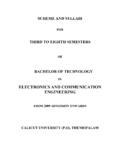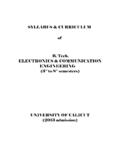Transcription of Section 5 High Speed PCB Layout Techniques - TI.com
1 high Speed analog design and Application Seminar Section 5. high Speed PCB Layout Techniques Scenario: You have spent several days, no maybe weeks, perfecting a design on paper and also using Spice to ensure the design exceeds all expectations. You hand the schematic to your Layout person who puts all everything on a printed circuit board (PCB). The PCB comes back in a week or two and is finally populated and ready to test. But it doesn't work!!!! Why not? On paper it works!! Spice said it works!! But it doesn't work!! This scenario happens more often than not and the reason many circuits do not work as expected is due primarily to the PCB Layout . This Section looks at some key fundamentals of high Speed PCB Layout Techniques so that hopefully the above scenario will never happen to you. 5-1. texas instruments high Speed analog design and Application Seminar PCB Components Component: Copper Traces Purpose: Interconnect two or more points Problem: Inductance and Capacitance h.
2 R w L(nH) 2x ln . t w + t . ( r + ). h C(pF) . h . x = length of trace (cm) ln . w = width of trace (cm) w + t . h = height of trace (cm). L(nH). t = thickness of trace (cm) Z 0 ( ) = T p ( ps/cm ) = L(nH)C(pF). C(pF). er = PCB Permeability ( ) trace on ( ) thick PCB (FR-4) has: 4nH and per cm er = PCB material 10nH and per inch permeability (FR-4 ). The PCB consists of layers of metal and insulator and can consist of several layers. Examining some common elements of a PCB will help the reader understand what many people believe is Black Magic . Copper traces are utilized to connect one element node to another node. The shape of these traces determine one very important aspect of a PCB. the characteristic inductance, capacitance, and ultimately the characteristic impedance. Resistance is generally ignored as most designs do not carry more than several mA of current and the results can often be negligible. Characteristic impedance (Z0) was covered previously, so this will not be discussed here.
3 But what is important is the inductance and capacitance as determined by the trace dimensions and the PCB dielectric ( r). FR-4, probably the most common PCB material used by manufacturers today and has a permeability range normally from to , but is often used as a typical permeability. Check with the PCB manufacturer to determine what material they utilize and the associated permeability. NOTE: Reference the book entitled high - Speed Digital design A. Handbook for Black Magic written by Howard Johnson and Martin Graham, 1993, Prentice-Hall, ISBN 0-13-395724-1. 5-2. texas instruments high Speed analog design and Application Seminar PCB Components Component: Copper Planes Purpose: Used For Ground Planes and Power Planes Problem: Stray Capacitance on Signal Traces Benefit: Large Bypass Capacitance & Minimal Inductance w r A. C(pF) . h l A. h = separation between planes (cm). A = area of common planes = l*w (cm2). er = PCB Permeability h r ( ) thick PCB (FR-4) has: per cm2 er = PCB material permeability (FR-4 ).
4 Per inch2. Copper planes are typically found when power planes and ground planes are utilized. Planes make an excellent high frequency capacitor and can often be utilized for high frequency bypassing in complement with traditional capacitors. The use of a solid ground plane is generally preferred over a grid plane. A. solid plane minimizes inductance to the absolute minimum which is a desirable trait for high Speed signals which includes both analog and Digital signals. But, as will be discussed later, this plane can cause capacitance problems to sensitive nodes of the circuit. Be aware of all attributes of the circuit and do not blindly use planes everywhere. A side benefit of a solid plane is it becomes a very good thermal conductor and can act as a heat sink to keep thermal levels of all devices minimized. But on the flip side, temperature sensitive components may not want to have the ground plane nearby due to this heat spreading.
5 5-3. texas instruments high Speed analog design and Application Seminar PCB Components Component: Vias Purpose: Interconnect traces on different layers Problem: Inductance and Capacitance h 4h . L(nH) 1 + ln . 5 d . 0 . 0555 r h d 1. C(pF) . d 2 d1. L(nH). Z 0 ( ) = T p ( ps/cm ) = L(nH)C(pF). C(pF). ( ) via with ( ) thick PCB has ( ) Clearance hole around ( ) pad on FR-4 has er = PCB material permeability (FR-4 ). Vias are utilized to simplify trace routing around other components or when there is a high density of interconnections to be made ( BGA. packages). Just as a PCB trace had inductance and capacitance, so to does a via. Generally these elements are ignored as the length of the vias are typically very small relative to the rest of the trace. But, this Can cause issues if the signals are very high frequency (>100 MHz) or have energy /. harmonics at high frequencies. The easiest way to minimize problems of a via is to simply not use them with signal traces.
6 At the very least it should be minimized. If vias must be used, there are other issues to worry about that will be discussed later. 5-4. texas instruments high Speed analog design and Application Seminar Current Density IO 1. i(A/cm) = w h D . 2 r 1+ t h . h IO = total signal current (A) i(A/cm). h = height of trace (cm). D = distance from trace (cm). D. Illustrates Return Current Flow is directly below the signal trace. The creates the path of least impedance. Must have Solid return path ( Solid Ground Plane). under the signal trace to maintain homogeneous nature of current density. Current density is the concentration of current flowing through a conductor. This is especially important when looking at return currents. One thing that many people forget about is for a current to flow out to a point, there MUST be a return path or else current will Not flow. Since there is a current flow, then the return current flow will find a way back to its' source one way or another.
7 Return current density is highest directly under (or over) the signal trace it was sourced from. Even if a solid ground plane is used, the concentration of current flow will still be adjacent to the signal source trace. 5-5. texas instruments high Speed analog design and Application Seminar high Frequency Input Current Path high Frequency Current Paths Always Follow the Path of Least Impedance - Not Resistance. Via V ia V ia RTERM. NOISE. - No + Top Layer Noise Picks up C urrent Flow Break in GND HF Return - Thru B otttom Layer Plane +. Reference C urrent Flow Reference is Quiet . Via to Bottom RTERM V ia to B ottom V ia to B ottom R T ER M R T ER M. GND Plane G N D P lane G N D P lane WORST BAD BETTER BEST. Large Current Loop + Large Reduced Minimum Current Discontinuous GND Current Loop Current Loop Loop Plane As just discussed, the lowest impedance path of a high Speed signal is directly under a PCB trace. This minimizes the current loop area substantially.
8 The worst . case scenario shows a long winding trace creates a large current loop area which is made even worse by the break in the ground plane. The obvious issue with this is the ground plane is often used as a reference point for other parts of the system. If the current flow density is high near one of these reference points, this can (and often does) cause noise to occur in the circuit and often propagates throughout the entire signal flow. As the bad Layout shows, also shows a long winding trace that does not follow the shortest distance between two points is a straight line method. The better Layout minimizes the distance while reducing the current loop area. But, the best way to do the Layout is to place the receiver part as close as possible to the input. This easily is the smallest loop area and delays in the signal path are drastically reduced. A key benefit of this method is the reference ground point for other circuits are kept quiet.
9 And should have no contribution from the undesirable current flow. This also minimizes the need for adhering to strict strip-line Techniques as the signal path acts as a lumped circuit and not a distributed circuit. A lumped circuit typically has rising edges much less than the delay time of the transmission line, thus minimizing issues. The construction of transmission lines naturally keeps the source and return currents close to each other. This helps minimize current loop area and drastically reduces noise along the path on the PCB and also EMI. 5-6. texas instruments high Speed analog design and Application Seminar high Frequency Output Current Path +VS. Problems: Long winding path causing large current loop area. HF bypass caps are placed too far away from amplifier and GND. Inductance eliminates benefit of bypass caps. -VS. GND of bypass caps are too far away from amplifier output. Series Resistor (RSOURCE). is too far away from the amplifier.
10 Causes C-loading on amplifier and lack of a transmission line. RSOURCE. Single GND point on connector Looking at the Output current path shows the exact same phenomenon as the input current flow the return current path will follow the signal trace path wherever it may go. One issue that is often overlooked is where does this return current flow once it reaches the output of the driver? As we all know, current must close the loop or else there is no current flow. In the example above, the return current flows through the bypass capacitors and back into the power supply lines. Now we see that the bypass capacitors are part of the loop and will have impact on the performance of the system. Obviously it makes sense to place the capacitors as close as possible to the driver power supply pins and the actual output trace. Another issue with the above system is the source resistance is very far away from the driver. As will be discussed later, this is a bad thing for the driver and may cause stability problems.












